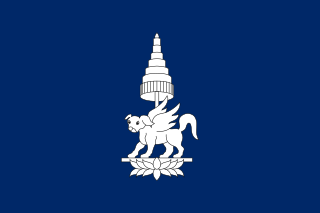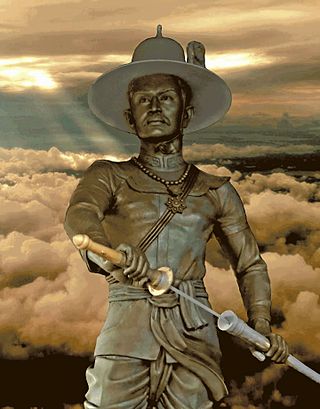
The Tai ethnic group migrated into mainland Southeast Asia over a period of centuries. The word Siam may have originated from Pali or Sanskrit श्याम or Mon ရာမည, probably the same root as Shan and Ahom. Xianluo was the Chinese name for Ayutthaya Kingdom, merged from Suphannaphum city state centered in modern-day Suphan Buri and Lavo city state centered in modern-day Lop Buri. To the Thai, the name has mostly been Mueang Thai.

Prince Boun Oum was the son of King Ratsadanay, and was the hereditary prince of Champassak and also Prime Minister of the Kingdom of Laos from March 1949 to February 1950 and again from December 1960 to June 1962.

Prince Phetsarath Ratanavongsa (Somdej Chao Maha Uparaja Petsaraj Ratanavongsa was the 1st Prime Minister of Luang Phrabang in French Laos from 21 August 1941 to 10 October 1945, and Head of State of Laos between 12 October 1945 and 4 April 1946.

Sisavang Vatthana or sometimes Savang Vatthana was the last king of the Kingdom of Laos and the 6th Prime Minister of Laos serving from 29 October to 21 November 1951. He ruled from 1959 after his father's death until his forced abdication in 1975. His rule ended with the takeover by the Pathet Lao in 1975, after which he and his family were sent to a re-education camp by the new government.

Nangklao, birth name Thap, also styled Rama III, was the third king of Siam under the House of Chakri, ruling from 21 July 1824 to 2 April 1851.

Phra Phutthayotfa Chulalok Maharaj, personal name Thongduang (ทองด้วง), also known as Rama I, was the founder of the Rattanakosin Kingdom and the first monarch of the reigning Chakri dynasty of Siam. His full title in Thai is Phra Bat Somdet Phra Paramoruracha Mahachakkriborommanat Phra Phutthayotfa Chulalok. He ascended the throne in 1782, following the deposition of King Taksin of Thonburi. He was also celebrated as the founder of Rattanakosin as the new capital of the reunited kingdom.

Pakse is the capital and most populous city of the southern Laotian province of Champasak, and the second most populous city in Laos. Located at the confluence of the Xe Don and Mekong Rivers, it has a population of about 95,000. Pakse was the capital of the Kingdom of Champasak until it was unified with the rest of Laos in 1946.

Norodom was King of Cambodia from 19 October 1860 to his death on 24 April 1904. He was the eldest son of King Ang Duong and was a half-brother of Prince Si Votha and King Sisowath. He was elected to the throne in 1860 but would not be crowned until 1864 due to the fact that Siam held the royal regalia. In 1863, he signed a treaty with France by which he gave France control over Cambodia's foreign relations in exchange for personal protection against his enemies. The treaty saved Cambodian independence, but French control over Cambodia's internal affairs strengthened continually until the end of his reign. His reign of 43 years and 188 days is the longest in Cambodian history in terms of verifiable exact date. Upon his death, he was succeeded by his half-brother, Sisowath.

The House of Champassak or the Na Champassak family was an important Lao royal house, descendants of Chao Yuttithammathon, the 11th King of the Kingdom of Champassak whose prominent members include Prince Boun Oum Na Champassak and Prince Sisouk na Champassak. It was the ruling house of the former Kingdom of Champassak, with territories reaching on both banks of the Mekong river.

Somdet Chaophraya Borom Maha Sri Suriwongse, whose personal name was Chuang Bunnag, was a prominent 19th century Thai figure who served as the regent during the early years of the reign of King Chulalongkorn.

The French protectorate of Laos was a French protectorate in Southeast Asia of what is today Laos between 1893 and 1953—with a brief interregnum as a Japanese puppet state in 1945—which constituted part of French Indochina. It was established over the Siamese vassal, the Kingdom of Luang Phrabang, following the Franco-Siamese War in 1893. It was integrated into French Indochina and in the following years further Siamese vassals, the Principality of Phuan and Kingdom of Champasak, were annexed into it in 1899 and 1904, respectively.

Rangsit Prayurasakdi, Prince of Chai Nat was the Thai Founder of the Public Health Ministry and as Regent of Thailand.

Chao Phraya Bodindecha, personal name Sing Sinhaseni, was a prominent military figure of the early Rattanakosin Kingdom period during the reign of King Rama III. Bodindecha hold the post of Samuha Nayok (สมุหนายก) the Prime Minister of Northern Siam from 1827 to 1849. He was known for his leading roles in putting down the Laotian Rebellion of King Anouvong of Vientiane (กบฏเจ้าอนุวงศ์) and Siamese-Vietnamese Wars in 1831–1834 and 1841–1845 (อานัมสยามยุทธ). His descendants bear the surname Sinhaseni (สิงหเสนี).

The Kingdom of Champasak or Bassac, (1713–1904) was a Lao kingdom under Nokasad, a grandson of King Sourigna Vongsa, the last king of Lan Xang and son-in-law of the Cambodian King Chey Chettha IV. Bassac and the neighboring principalities of Attapeu and Stung Treng emerged as power centers under what was later to be described as the Mandala Southeast Asian political model.

The Siamese–Vietnamese War of 1831–1834, also known as the Siamese-Cambodian War of 1831–1834, was sparked by a Siamese invasion force under General Bodindecha that was attempting to conquer Cambodia and southern Vietnam. After initial success and the defeat of the Khmer Army at the Battle of Kompong Cham in 1832, the Siamese advance was repelled in southern Vietnam in 1833 by the military forces of the Nguyễn dynasty. Upon the outbreak of a general uprising in Cambodia and Laos, the Siamese withdrew, and Vietnam was left in control of Cambodia.

The Siamese–Vietnamese War of 1841–1845 was a military conflict between the Đại Nam, ruled by Emperor Thiệu Trị, and the Kingdom of Siam, under the rule of Chakri King Nangklao. The rivalry between Vietnam and Siam over the control of the Cambodian heartlands in the Lower Mekong basin had intensified after Siam had attempted to conquer Cambodia during the previous Siamese–Vietnamese War (1831–1834). Vietnamese Emperor Minh Mạng installed Princess Ang Mey to rule Cambodia as a puppet queen regnant of his choice in 1834 and declared full suzerainty over Cambodia, which he demoted to Vietnam's 32nd province, the Western Commandery. In 1841, Siam seized the opportunity of discontent to aid the Khmer revolt against Vietnamese rule. King Rama III sent an army to enforce Prince Ang Duong's installation as King of Cambodia. After four years of attrition warfare, both parties agreed to compromise and placed Cambodia under joint rule.

King Taksin the Great or the King of Thonburi was the only king of the Thonburi Kingdom that ruled Thailand from 1767 to 1782. He had been an aristocrat in the Ayutthaya Kingdom and then was a major leader during the liberation of Siam from Burmese occupation after the Second Fall of Ayutthaya in 1767, and the subsequent unification of Siam after it fell under various warlords. He established the city of Thonburi as the new capital, as the city of Ayutthaya had been almost completely destroyed by the invaders. His reign was characterized by numerous wars; he fought to repel new Burmese invasions and to subjugate the northern Thai kingdom of Lanna, the Laotian principalities, and a threatening Cambodia.

Field Marshal Prince Chirapravati Voradej, Prince of Nakhon Chaisi was a prince of the Chakri Dynasty and influential military officer of Siam. The prince was a son of King Chulalongkorn and Chao Chom Manda Thapthim Rochanatisha. He was the king's 17th child.
![King Ratsadanay (1874-1945). H.R.H. Somdet Brhat Chao Buvanarabarna Rajadhanaya Negara Champasakti [Bua Laphan Ratsadany], Prince of Champasakti. Champassak-Bua Laphan Ratsadany.jpg](http://upload.wikimedia.org/wikipedia/commons/thumb/3/32/Champassak-Bua_Laphan_Ratsadany.jpg/220px-Champassak-Bua_Laphan_Ratsadany.jpg)

















